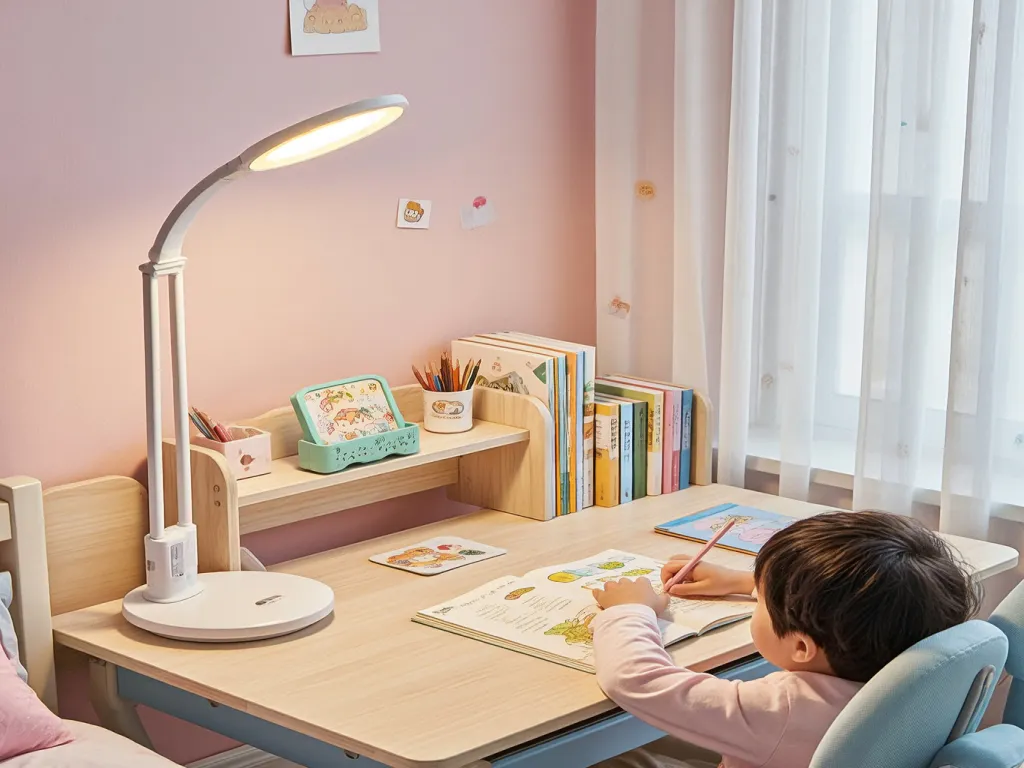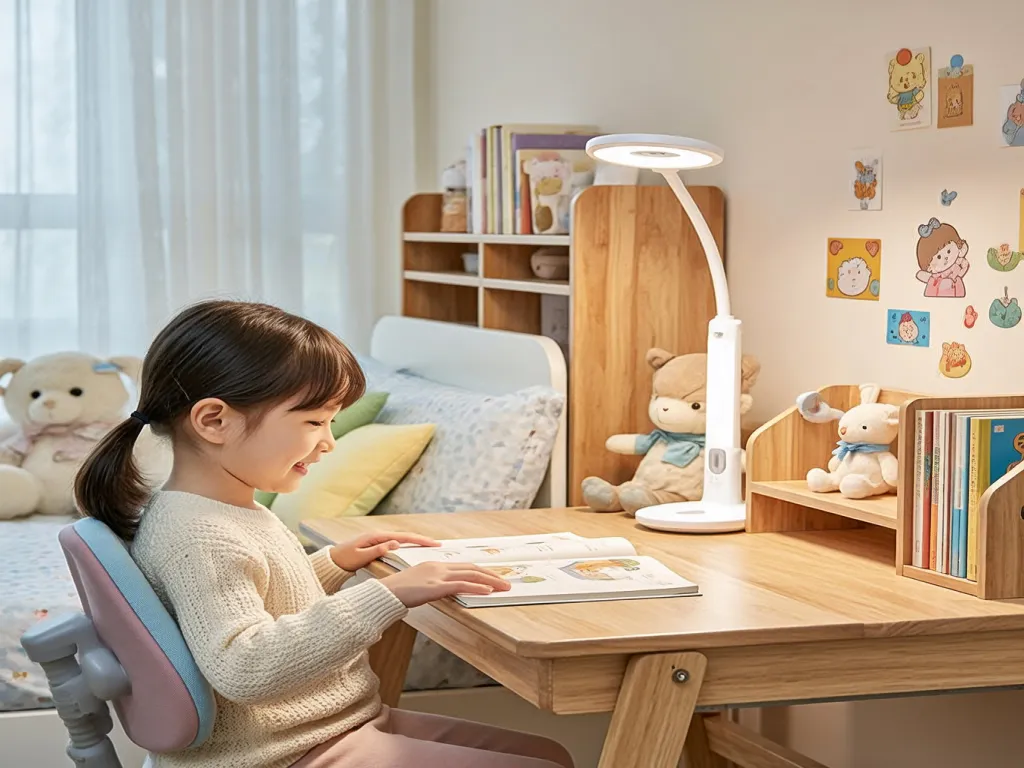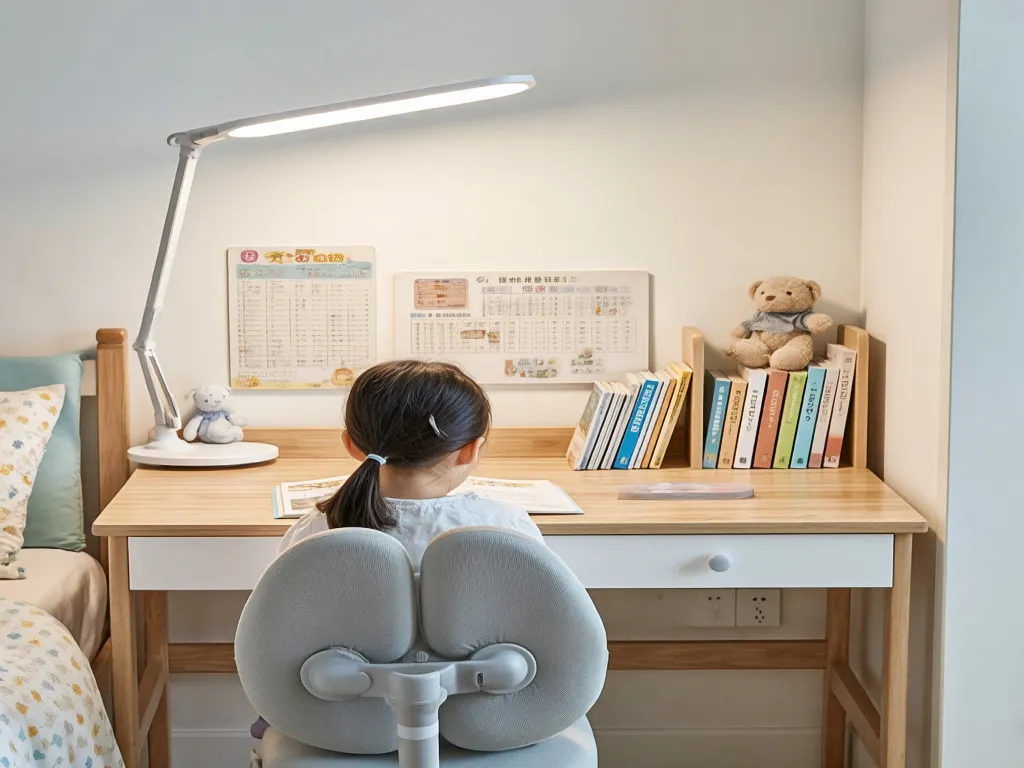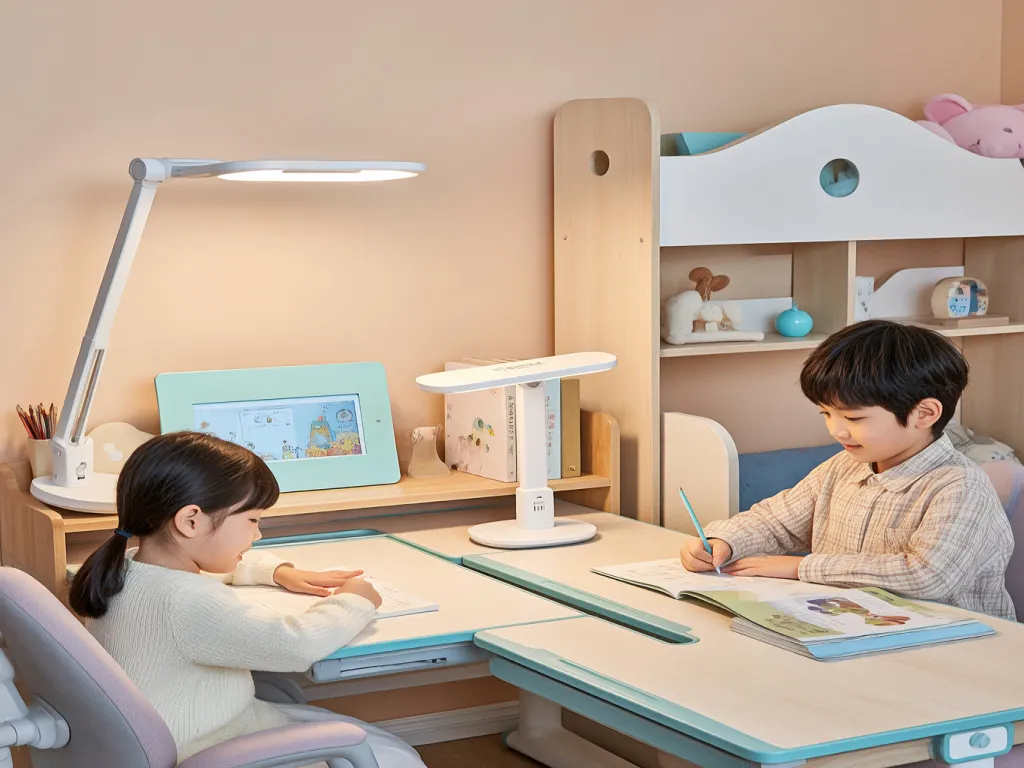Guide to Desk Lamp for Children: Brightness & Color
As a parent, you want nothing but the best for your child, especially when it comes to their health and well-being. When selecting a desk lamp for your little one, have you ever wondered how light brightness and color temperature can affect their vision? This blog is here to help you navigate through the world of children’s desk lamps, offering insights on how to choose the perfect one that not only illuminates their study space but also protects their precious eyes. So, let’s dive in and explore the essentials of selecting the ideal desk lamp for children!

The Importance of Desk Lamp Brightness: Understanding the Impact of Different Brightness Levels on Children’s Vision and How to Choose the Right Brightness for Room Size and Usage Scenarios
When it comes to choosing a desk lamp for your child, one of the most critical factors to consider is the brightness of the light. The right brightness can significantly impact your child’s vision and overall well-being. Let’s dive into why brightness matters and how you can select the perfect level for your child’s needs.
Why Brightness Matters
First off, let’s talk about why the brightness of a desk lamp is so important for children. The eyes of children are still developing, and they are more sensitive to light than adults. Inadequate lighting can lead to eye strain, headaches, and even long-term vision problems. On the other hand, overly bright light can cause discomfort and glare, which can also be detrimental to their eyesight. According to a study, improper lighting conditions can exacerbate these issues, making it crucial to get the brightness just right.
Impact of Different Brightness Levels
- Too Dim: When a desk lamp is too dim, it forces your child to strain their eyes to see clearly. This can lead to fatigue, dry eyes, and even myopia (nearsightedness) over time. Imagine trying to read a book in a dimly lit room—it’s not only frustrating but also hard on the eyes.
- Too Bright: Conversely, if the lamp is too bright, it can create glare on the page or screen, making it difficult for your child to focus. This can also cause discomfort and even headaches. It’s like looking directly into a bright light—it’s painful and distracting.
- Just Right: The ideal brightness level is one that provides enough light to read, write, or work on a computer without causing any strain or discomfort. This balance is crucial for maintaining good vision and overall eye health.
Choosing the Right Brightness
Now that we understand why brightness matters, let’s talk about how to choose the right level for your child’s desk lamp.
1. Consider the Room Size
The size of the room plays a significant role in determining the appropriate brightness level. In a small room, a lamp with a lower wattage or a dimmer switch might be sufficient. However, in a larger room, you’ll need a brighter lamp to ensure adequate lighting throughout the space.
2. Assess the Usage Scenario
Think about how your child will be using the desk lamp. If they’re primarily using it for reading or writing, a moderate brightness level should suffice. But if they’re also using it for activities like drawing or crafting, which require more detailed work, you might want to opt for a brighter lamp.
3. Use a Dimmer Switch
One of the best features you can look for in a desk lamp is a dimmer switch. This allows you to adjust the brightness level according to your child’s needs and the time of day. For example, you might want to keep the light dimmer in the evening to promote relaxation before bedtime.
4. Test the Light
Before making a final decision, it’s a good idea to test the light in the actual room where your child will be using it. Sit at the desk and see how the light feels on your eyes. Does it provide enough illumination without causing any strain or discomfort? If so, you’ve found the right brightness level.

Conclusion
Choosing the right brightness level for your child’s desk lamp is crucial for their vision and overall well-being. By considering the room size, usage scenario, and using a dimmer switch if possible, you can ensure that your child has the perfect lighting conditions for studying, reading, and playing. Remember, a well-lit environment is not only good for their eyes but also for their mood and productivity. So, take the time to choose the right desk lamp brightness—your child’s eyes will thank you!
Examples of Brightness Levels
To give you a better idea of what different brightness levels look like, here are some examples:
- Low Brightness (100-200 lumens): This level is suitable for creating a cozy, relaxing atmosphere. It’s perfect for reading before bedtime or doing light activities.
- Medium Brightness (300-500 lumens): This is the ideal level for most reading, writing, and studying tasks. It provides enough light to see clearly without causing any strain.
- High Brightness (600+ lumens): This level is best for detailed work like drawing, crafting, or using a computer. It ensures that every detail is visible and reduces the risk of eye strain.
Tips for Maintaining Good Eye Health
In addition to choosing the right brightness level for your child’s desk lamp, there are a few other tips you can follow to maintain good eye health:
- Take Regular Breaks: Encourage your child to take regular breaks from studying or using electronic devices. This gives their eyes a chance to rest and recover.
- Adjust the Screen Brightness: If your child is using a computer or tablet, make sure the screen brightness is adjusted to match the ambient lighting in the room. This reduces glare and eye strain.
- Eat a Balanced Diet: A diet rich in vitamins A, C, and E, as well as omega-3 fatty acids, can help maintain good eye health. Include plenty of fruits, vegetables, and fish in your child’s diet.

The Art of Color Temperature Selection: Exploring the Impact of Different Color Temperatures on Children’s Emotions and Focus, Recommending Suitable Ranges for Study and Rest
When it comes to choosing the perfect desk lamp for your child, color temperature is a factor that often gets overlooked, yet it plays a crucial role in their overall well-being and productivity. Color temperature, measured in Kelvins (K), refers to the warmth or coolness of the light emitted by a bulb. Different color temperatures can evoke different emotional responses and affect a child’s ability to concentrate. So, how do you decide which color temperature is best for your child? Let’s dive into the fascinating world of color temperature and its impact on children.
Understanding the Emotional Impact of Color Temperature
Color temperature can have a profound impact on a child’s emotions. Warm white light, with its soft, yellowish glow, can evoke feelings of warmth, comfort, and security. This type of light is often used in bedrooms and living rooms to create a cozy and inviting atmosphere. For children, warm white light can be particularly soothing and can help them feel more relaxed and at ease. On the other hand, cool white light, with its bright, bluish-white glow, can create a more stimulating and energizing environment. While this can be beneficial during study sessions or activities that require high levels of focus, it may not be the best choice for bedtime or relaxation. A study from PMC4668153 suggests that the color temperature of light can indeed influence mood and cognitive performance, further emphasizing the importance of choosing the right light for your child.
Recommended Color Temperature Ranges for Study and Rest
When it comes to choosing the right color temperature for your child’s desk lamp, it’s important to consider their specific needs and activities. For study sessions, a neutral white light around 4000K is often the best choice. This color temperature provides a bright, clear light that helps children stay focused and alert without causing eye strain. It’s also ideal for activities that require detailed work, such as reading, writing, or drawing. For rest and relaxation, a warm white light around 2700K can create a cozy and calming atmosphere. This type of light is perfect for bedtime stories, meditation, or simply unwinding after a long day. By adjusting the color temperature of your child’s desk lamp according to their activities, you can help them achieve the best possible balance between focus and relaxation.
Practical Tips for Choosing the Right Color Temperature
Choosing the right color temperature for your child’s desk lamp doesn’t have to be complicated. Here are a few practical tips to help you make the best decision:
- Observe your child’s reactions to different types of light. Do they seem more focused and alert under neutral white light? Or do they prefer the cozy, calming effect of warm white light?
- Consider the time of day and the activity at hand. For study sessions, opt for neutral white light. For bedtime or relaxation, switch to warm white light.
- Invest in a desk lamp that offers adjustable color temperature settings. This will give you the flexibility to easily switch between different color temperatures depending on your child’s needs.
- Keep in mind that the impact of color temperature can vary from child to child. What works for one child may not work for another, so be prepared to experiment and find the best color temperature for your child.

Practical Case Studies: Adjusting Light Brightness and Color Temperature for Optimal Vision
Now that we’ve covered the importance of light brightness and the art of selecting color temperature, let’s dive into some real-life examples to see how these principles can be applied to create the perfect study environment for your child. We’ll explore three different scenarios, each tailored to a specific age group, learning habit, and room decor, demonstrating how to adjust the desk lamp’s brightness and color temperature to achieve the best visual effect.
Case Study 1: The Preschooler’s Playful Study Nook
Imagine a cozy corner in your preschooler’s bedroom, decorated with vibrant colors and soft toys. This space is designed for both play and early learning activities. For such a young child, the desk lamp should emit a warm, inviting glow that encourages creativity and relaxation. A brightness level of around 300-400 lumens is ideal, providing enough light for coloring, reading picture books, or engaging in simple puzzles without overwhelming their developing eyes. The color temperature should be set to a warm white, around 2700K, which mimics the soft, golden light of a sunset, creating a calming atmosphere that’s perfect for winding down after a day of play. This approach aligns with research suggesting that warm lighting can positively influence children’s mood and behavior, as discussed in this study.
Case Study 2: The Elementary Student’s Focused Study Space
As your child enters elementary school, their study needs become more specific, requiring a desk lamp that supports concentration and productivity. A dedicated study area, perhaps with a neutral-toned desk and minimalist decor, calls for a brighter light to keep them alert and engaged. A brightness of 600-800 lumens is recommended, ensuring that the workspace is well-lit without causing glare or shadows. The color temperature should be adjusted to a cool white, around 4000K, which enhances focus and alertness, making it easier for your child to tackle homework and projects. Research indicates that cooler lighting can improve cognitive performance, as highlighted in this research on dynamic lighting effects.
Case Study 3: The Teen’s Modern Study Hub
For teenagers, the study area often doubles as a space for relaxation and socializing, with a more mature and sophisticated decor. To accommodate these diverse needs, the desk lamp should offer flexibility in both brightness and color temperature. A brightness range of 800-1000 lumens is suitable for intensive studying, while the ability to switch to a warmer, more ambient light (around 3000K) when they want to unwind or chat with friends is invaluable. Some modern desk lamps even come with smart features, allowing for easy adjustment via smartphone apps or voice commands, making it effortless to create the perfect lighting environment for any occasion. This adaptability is crucial, as studies like this one on lighting and student attitudes suggest that personalized lighting can enhance both academic performance and overall well-being.
Choosing the right desk lamp for your child is more than just a purchase; it’s an investment in their future. By considering factors like brightness and color temperature, you’re taking a proactive step towards safeguarding their vision. Remember, a well-lit study environment can significantly enhance your child’s learning experience. So, why wait? Start exploring our collection of children’s desk lamps today and find the perfect match for your little one’s needs. And don’t forget, sharing this guide with fellow parents could be a great way to help them make informed decisions too. Let’s light up our children’s futures, one desk lamp at a time!
